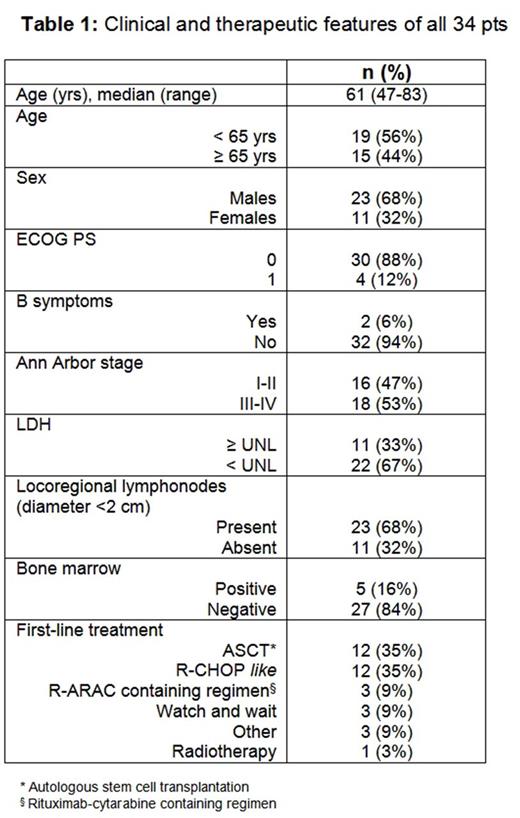Abstract
INTRODUCTION: Mantle Cell Lymphoma (MCL) is considered an aggressive B-cell lymphoma, but with a heterogeneous outcome and a median overall survival ranging from 3 to 5 years (yrs). Two different subsets are recognized, known as "classical" and "leukemic non-nodal" subtypes. Unfrequently MCL presents with isolated extranodal localization mimicking mucosa-associated lymphoid tissue (MALT) lymphomas; a large series of European Mantle Cell Network has been recently reported (Morello et al, ICML 2017). On the other side, pathological features of this peculiar presentation are not yet clarified.
METHODS: We collected data on 34 patients (pts) with extranodal mantle cell lymphoma (EMCL) of MALT site, diagnosed between 2001 and 2016 in 10 Italian Centers of Fondazione Italiana Linfomi (FIL) network. The diagnosis of MCL was confirmed through detection of CyclinD1 overexpression and/or t(11;14). All pts were >18 yrs and HIV negative. Only minimal locoregional nodal involvement, with CT longest axis <2 cm, and bone marrow involvement with only extranodal disease were allowed. Pts with splenomegaly and leukemic disease were excluded. We performed a central pathological review of 21/34 cases (62%) in the Section of Anatomic Pathology of University of Pavia and compared their features with a cohort of nodal MCL.
RESULTS: Clinical features and treatments are summarised in Table 1.
Biopsied extranodal sites were as follows: 11 pts (32%) Waldeyer's ring, 11 (32%) gastrointestinal tract, 3 (9%) ocular adnexa, 3 (9%) oral cavity, 3 (9%) salivary glands, 2 (6%) thyroid and 1 (3%) liver. Detailed morphology was assessed in 28 pts: classical in 22 pts (78%), pleomorphic in 3 (11%) and blastoid in 3 (11%). CD5 expression was performed in 31 cases: 21 (68%) positive, 6 (19%) partially positive and 4 (13%) negative. Median Mib1/Ki67 was low (15%, range: 2-70%), <30% in 83% and ≥30% in 17% cases. CyclinD1 was available in 33 pts (88% positive, 3% negative, 9% partially positive) and t(11:14) in 13 pts (92% positive). SOX11 staining was performed in 21 cases: 17 (81%) resulted positive, 3 (14%) partially positive and only 1 (5%) negative. Overall, no statistically significant difference with nodal MCL series was observed, particularly regarding cytological features, CD5 and SOX11 expression and Mib1/Ki67. MIPI score was calculated in 33 pts: 15 (46%) low, 13 (39%) intermediate and 5 (15%) high; biologic-MIPI score was available in 29 pts: 7 (24%) low, 14 (48%) intermediate and 8 (28%) high.
After a median follow-up of 5.1 yrs (0.5-15), overall survival (OS) was 93% at 5 yrs and 75% at 10 yrs with 4 deaths (2 for lymphoma, 2 for unknown cause). All the 12 pts treated with autologous stem cell transplantation was still alive at last follow-up. Progression-free survival (PFS) was 74% after 5 yrs and 64% after 10 yrs of follow-up. Univariate analysis results are overlapping with European series: pts with age <65 yrs (p=0.002), ECOG 0 (p=0.012), low MIPI score (p=0.005) and low biologic MIPI score (p=0.008) had a longer OS. In univariate analysis, a longer PFS was observed in pts with age <65 yrs (p=0.016), ECOG 0 (p=0.002), low MIPI score (p<0.001) and low biologic MIPI score (p=0.011). In multivariate analysis, age (p=0.022) confirmed its impact on PFS, after adjusting for biologic MIPI score.
CONCLUSIONS: According to our preliminary data, we define EMCL as a subset with preferential involvement of Waldeyer's ring and gastrointestinal tract, mimicking the clinic-pathologic features of marginal zone lymphoma of extranodal sites, from which it should be differentiated via a thorough histologic characterization, and featuring the indolent course of the indolent variant of MCL. On the other hand, our cases harbored the morphologic and phenotypic features of the nodal form of MCL. On the basis, the true nature of this putative MCL subset should be deepened upon biologic characterization, including mutational and IGVH status analysis.
Loseto: gilead: Membership on an entity's Board of Directors or advisory committees; janssen: Consultancy; italfarmaco: Membership on an entity's Board of Directors or advisory committees. Arcaini: Pfizer: Membership on an entity's Board of Directors or advisory committees; Celgene: Consultancy, Membership on an entity's Board of Directors or advisory committees; Bayer: Membership on an entity's Board of Directors or advisory committees; Roche: Consultancy, Membership on an entity's Board of Directors or advisory committees; Sandoz: Consultancy; Gilead: Research Funding. Zaja: Novartis: Honoraria, Research Funding; Roche: Honoraria, Research Funding; Abbvie: Honoraria; Takeda: Honoraria; Gilead: Honoraria; Janssem: Honoraria; Celgene: Honoraria, Research Funding.
Author notes
Asterisk with author names denotes non-ASH members.


This feature is available to Subscribers Only
Sign In or Create an Account Close Modal